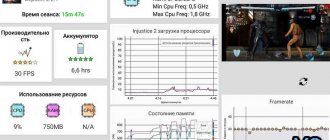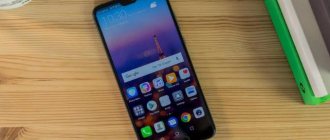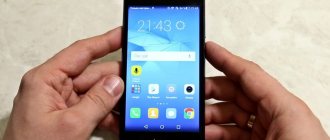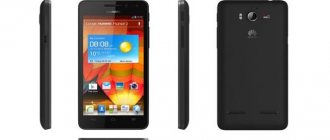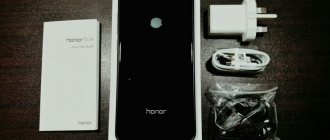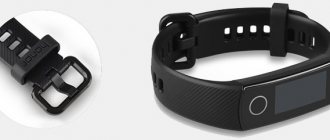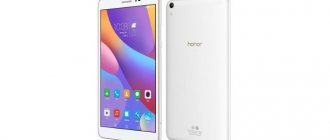Appearance
I wonder what impression the Honor 6 makes on outsiders. "ABOUT! It’s an iPhone!” I heard more than once. I don’t know whether the manufacturer’s goal was to bring the appearance of these devices as close as possible, but he definitely succeeded. The device really, with its shape and metallic edging, is very reminiscent of the fourth generation iPhone. Even the camera with the same chrome hoop is in the same place. How can such parallels not arise here?
On the front side there is a screen, which is covered with a protective glass panel with an oleophobic coating. The frames around the display are 2.86 mm thick (yes, we have everything exactly), so nothing is annoying and everything is as convenient as possible: there are no accidental clicks.
Above the screen there is a speaker grid, a light and proximity sensor hole and, of course, the front camera, but below there is complete emptiness. Due to the transfer of touch keys to the display, the smartphone is conveniently held in a horizontal orientation. Fans of portable movies and games will definitely appreciate it.
There's nothing on the left side, so let's move on. On the right side there are all the controls: the volume and power keys, as well as plastic plugs, under which the slot for the SIM card and microSD card is hidden.
Why the plugs were used here is unknown, since the smartphone is afraid of dust and water as well as fire.
The bottom end is “rich” only with a microphone hole and a microUSB connector in the center. On the top side we can see another microphone hole, an infrared port for controlling household appliances and a regular audio output.
The main speaker of the device is located on the back side, which can lead to slight muffling of the sound if the device is lying face up. All elements on the back side are made flush, so the device lays flat on any smooth surface.
The back cover is made of an unknown material, reminiscent of somewhat soft, glossy plastic. The guys from Huawei explain that the back cover is a real pie made of six composite materials used in astronautics. Nothing more is specified. In practice, at certain angles, you can see a circular pattern in the depths of the dark surface. This is not immediately noticeable, so there is no need to talk about any additional wow effect.
In addition, unfortunately, the back cover very quickly becomes covered with scratches of various sizes.
I tried to reflect this in the photo. It seems that in order for the smartphone not to turn into a devil with horns after a year of use, it will be necessary to store it in some kind of case. There is another alternative: purchase a white model. Most likely, on white the grid of small scratches will not be so noticeable.
Now about the dimensions of the smartphone. It lies securely in your hand, does not slip out and is not prone to falling. The dimensions of the case are average, so the device is very easy to handle. The numbers will tell you more about all this.
| Length | Width | Thickness | Weight | |
| Huawei Honor 6 | 139,6 | 69,7 | 7,5 | 130 |
| Samsung Galaxy Alpha | 132,4 | 65,5 | 6,7 | 115 |
| iPhone 5S | 123,8 | 58,6 | 7,6 | 112 |
| Sony Xperia Z3 Compact | 127 | 64,9 | 8,6 | 129 |
| Apple iPhone 6 | 138,1 | 67 | 6,9 | 129 |
| Samsung Galaxy S5 | 142 | 72,5 | 8,1 | 145 |
Advantages and disadvantages of the Honor 6 phone
The dimensions of Huawei Honor 6 are 69.7 mm wide, 139.6 mm long and 7.5 mm thick. With such dimensions it is convenient to operate the device with one hand. In addition, the weight of the device is about 130 g. Even if you operate the device with one hand, its weight is almost not felt.
If we evaluate the overall ease of use of the phone taking into account the size and weight, then there will be no problems with everyday use.
The smartphone is equipped with an 8-core Huawei HiSilicon KIRIN 920 processor, which is made at 28 nm. technical process.
The smartphone has 3 GB. RAM, which is quite enough. In very rare cases it will not be enough, but with this amount of RAM, you will rarely have problems.
The device's data storage capacity is 16 GB, and while this is enough for photos, it may not be enough for video shooting and a large number of games.
The phone is compatible with SD cards, so you can easily expand its memory. So you probably don't need to worry about storage capacity.
Honor 6 has a 5-inch display diagonal. The display is large enough that you will rarely have problems with its size. However, this display is not suitable for writing long texts.
The smartphone has a high-end display and any graphic content you display on it, including videos and games, will be displayed clearly.
The main camera of the phone has 12.98 megapixels and can take high-resolution photos and videos. While you're shooting landscapes or printing high-definition photos, you may want a higher-resolution camera, but most of the time you'll be happy with the camera.
Also, the smartphone has a 5.04 megapixel front camera, which is average for smartphone cameras. This is good enough for taking selfies, but you may not be satisfied with group photos or their print quality.
The battery capacity of Huawei Honor 6 is 3100 mAh, which is a relatively large indicator. Compared to other smartphones, the battery life of the Huawei Honor 6 is good. With this capacity, you won't experience any problems even if you spend time on the Internet or Twitter for a long period of time. Even while playing games or watching videos, you can do so comfortably without worrying about battery life. However, some caution should be exercised when watching movies or playing games for too long.
Display
The screen is made using IN-CELL technology and covered with protective glass Corning Gorilla Glass 3. It is based on an IPS matrix.
A diagonal of five inches is the golden mean of convenience: the image is not small, but you can use the device quite comfortably. The use of Full HD resolution with 445 pixels per square inch is fully justified. There is no point in installing a panel with a higher pixel density. All fonts and rounded icons look very smooth and beautiful, so the appearance of the shell does not suffer at all.
The depth of colors, richness of colors, viewing angles pass all the highest selection criteria.
For clarity, I recommend paying attention to the comparison of the screen of the hero of today’s article with the display installed in the Samsung GALAXY Note 4 (pictured above).
Please note that from an angle the picture on Honor 6 looks even better: colors are not distorted and criminal greenish tints do not appear. And all this in a device that costs more than half the price of the flagship from the Korean giant.
If suddenly for some reason the color temperature of the screen does not suit you, you can adjust it from the settings.
Design and usability
Honor 6 is made in the style of the latest Huawei smartphones. The body contours are reminiscent of last year's Honor 3, and individual design elements echo those of the Ascend P7.
The body is made like a hamburger, the back of Honor 6 is absolutely flat. The entire front panel is covered with protective glass, while the side frame does not protrude above its surface. Above the screen you can see a thin slot for the earpiece, as well as windows for the front camera and sensors. The indicator light is hidden under the panel to the left of the sensors. The side frames are thin, 2.86 mm, and the display itself occupies 75.7% of the panel area. In addition, there is no manufacturer’s logo on the front side; on-screen control keys are used - this makes the appearance of the smartphone more laconic.
However, the back panel is also pleasing in the absence of a clutter of inscriptions - there is only the Honor line logo and service information.
The back of the smartphone is made of a special six-layer composite material. According to the manufacturer, the same materials are used in astronautics.
Under the top transparent layer we can discern a small dot pattern. In the case of a white smartphone, fingerprints on the panel are practically invisible; they can only be seen from a certain angle.
The camera, dual LED flash and speaker are built flush with the rear panel.
There is a plastic strip running along the three sides of the Honor 6, reminiscent of the frame in the Ascend P7. The left side is empty; on the top edge you can see a headset jack, a second microphone hole and an infrared transmitter window. The control buttons are concentrated on the right side. Below them are slots for Mini-SIM and memory cards. They are covered with a common plug, which practically merges with the frame. The MicroUSB connector and the main microphone hole are on the bottom edge.
Honor 6 is perfectly assembled, all the parts fit tightly together, the keys sit tightly in their places, the whole structure is quite rigid.
| Smartphone | Honor 6 | Huawei Ascend P7 | LG Nexus 5 | Samsung Galaxy S4 |
| Dimensions, mm | 139.6 x 69.7 x 7.5 | 139.8 x 68.8 x 6.5 | 137.84 x 69.17 x 8.59 | 136.6 x 69.8 x 7.9 |
| Weight, g | 130 | 124 | 130 | 130 |
| Battery capacity, mAh | 3100 | 2500 | 2300 | 2600 |
For a five-inch smartphone, Honor 6 has a fairly small body size; it is comparable to the most compact classmates.
Thanks to this, it fits comfortably in the palm of your hand, making Honor 6 easy to use. The ergonomics of the smartphone are at a good level, despite the use of flat, smooth panels, Honor 6 does not try to slip out of your hands. The power key is located just under the thumb, and the volume rocker is located slightly higher. They protrude slightly above the body and have a clearly visible pressure.
Technical characteristics of Huawei Honor 6 (H60-L04):
- Hi-Silicon Kirin 920 processor
- Mali T628 video chip
- RAM 3 GB (on a “bare” system 1941 MB is actually available)
- 16 GB data storage memory (10.69 GB available)
- memory card support (microSD up to 32 GB)
- display 5'', 1920 x 1080 pixels (445 ppi)
- battery 3000 mAh
- Sensors: accelerometer, light sensor, proximity sensor,
- compass, gyroscope
- ports: 3.5 mm audio output, microUSB 2.0 (OTG)
- OS: Android 4.4.2
- Shell version, EmotioinUI 2.3
- Dimensions 139.6 x 69.7 x 7.5 mm
- Weight 130 g
Networks:
- 2G (850/900/1800/1900 MHz), 3G (DC-HSPA+), 4G
- Wi-Fi (IEEE 802.11 b/g/n), Bluetooth 4.0, FM radio
- NFC is missing
- aGPS / GLONASS
- infrared port
And now more about hardware, fortunately, there is something to talk about. The processor is the brainchild of the fifth generation of chips from HiSilicon and is built using 28-nanometer technology on the big.LITTLE architecture. Four Cortex-A7 cores operate at 1.3 GHz, and 4 others (Cortex-A15) at 1.7 GHz. In general, eight cores are used, and very efficiently.
There are as many as three gigabytes of RAM installed here - how do you like this in a smartphone under 20,000 rubles? Dual-channel memory (LPDDR3) operates at a frequency of 800 MHz.
In advertising and press releases, the manufacturer focuses on the installed LTE cat 6 module, which supports both FDD bands: 1, 3, 7, 20, and TDD 38. Due to all this, a record speed of up to 300 Mbit/s is achieved.
So the smartphone has a very serious foundation for the future. It can remain relevant for quite a long time not only due to its iron insides, but also thanks to its network capabilities.
However, speaking about the latter, there is one disappointment.
The smartphone does not support NFC.
Apparently, one of the largest Chinese manufacturers simply does not like this communication standard. Well, I don’t like it, that’s all. What other logical explanation could there be?
In nature there is also a version with two SIM cards on board. In this case, support for memory cards does not disappear anywhere. A hole for a flash card is added directly under the slot of one of the SIM cards.
⇡#Communication
Huawei Honor 6 is the first smartphone officially shipped to Russia that supports fourth-generation networks with a theoretical limit for receiving information of 300 Mbit/s (LTE Cat. 6). Most gadgets are content with LTE Cat. 4 with speeds up to 150 Mbit/s. However, even this value in Russian realities still seems unattainable - in our vast expanses, the speed in 4G networks is much more modest, and the coverage area still leaves much to be desired.
The smartphone keeps its connection to the network confidently and does not lose it for no apparent reason. The earpiece volume reserve is sufficient for noisy places.
The set of wireless interfaces is unusual: the smartphone has Bluetooth, Wi-Fi, and even an infrared port, but the now familiar NFC is not here, which is somewhat strange. The purpose of the infrared port is not obvious - there is no built-in application for controlling household appliances in the smartphone. You have to use third-party utilities, and they may be unstable. But with Wi-Fi and Bluetooth everything is smooth: the device quite quickly connects to public access points and transmits music without delay to wireless speakers.
Huawei Honor 6 - AndroiTS GPS Test results outdoors
A GNSS module with support for GPS and GLONASS is responsible for navigation in the device. It works quite stably. Half a minute after activating the test, the gadget detected seventeen satellites of two navigation systems and was guided by eight of them. The navigation error radius was moderate - around 12-16 meters. It is noteworthy that the Chinese Huawei Honor 6 does not have support for BeiDou, a Chinese navigation system that is becoming quite popular in smartphones.
Performance
As can be seen from the synthetic tests, the efficiency of the installed hardware is at the level of the Sony Xperia Z2 and this is not bad at all, especially considering that the second “ZD” was presented in the spring of this year.
In other words, the place of a smartphone from Huawei among current flagships.
Of course, Honor 6 is far from the maximum rating values of the same AnTuTu, but this can only worry those who are chasing artificial “parrots”.
The smartphone's power is enough for all modern mobile games, and perhaps even more. The proprietary EmotionUI 2.3 shell flies everywhere in the system.
Nothing lags or slows down. In terms of this parameter, the device again leaves only positive impressions.
Performance and hardware
By tradition, Huawei devices are equipped with processors of their own design and production. Honor 6 was no exception. The Kirin 920 is installed here, based on the ARM big.LITTLE architecture. Its main feature is the presence of two groups of nuclei of 4 units each. One group is highly productive, the other is energy efficient. Due to this, the device itself can determine when to turn on powerful cores and when to save energy. By the way, the processor allows you to use these cores in any combination.
RAM – 3 gigabytes, flash memory 16 or 32 gigabytes, depending on the configuration. The device plays any games that you can find on Google Play. It can also play almost any video. The performance of the device is at a very high level; in AnTuTu Honor 6 showed an excellent result of 40 thousand points.
Front-camera
This is a separate conversation. The front camera uses a matrix with a resolution of 5 megapixels or 2592 x 1952 pixels for photographs. On top of it is an 88-degree wide-angle lens for panoramic portraits.
To photograph yourself and a crowd of friends, absolutely the same feature is used here as in the Samsung GALAXY Note 4. Huawei called it a panoramic portrait, the essence of which is to combine three shots into one wide one. To take such a shot, the smartphone must be tilted alternately left and right. Of course, it requires some skill and getting used to, but overall it’s not bad.
Despite the high resolution, the camera is very average. In general, you can independently evaluate the quality using the examples of photographs below.
Panoramic portrait
Regular pigeon selfie 2
Regular pigeon selfie
Camera
We won’t dwell too much on the device’s camera because it doesn’t represent anything special. The resolution of the front camera has increased to 5 megapixels, and its quality is enough for selfies that are so popular now. The main camera takes good pictures, but nothing more.
Even in good lighting it is a little noisy, but it is worth noting that the detail is at a high level. The color rendition is natural, but the image processing algorithms are not perfect.
Main camera
The smartphone has a 13-megapixel Sony Exmore RS photo sensor, which is capable of creating frames with a resolution of up to 4160 x 3120 pixels. The aperture has a value of f/ 2.0, which, in principle, can already be called an industry standard. A two-section LED flash is located next to the camera eye.
The developers claim that the focusing speed is 0.6 seconds. This isn't a record, especially considering the LG G3's 0.27 seconds, but it's still fast nonetheless. I didn’t notice any special autofocus errors, including when filming in the dark.
The picture turns out quite good. Detailing and color rendition are not poor. In good light, the camera of the device can be called successful, but when the ambient light falls, the dark areas of the frame become almost completely black and it does not look very interesting. In general, you can evaluate the level of shooting that Honor 6 offers using the examples I gave below.
The smartphone shoots video in resolutions up to 1920 x 1080 pixels and at the usual 30 frames per second. It is possible to activate tracking autofocus and enable image stabilization.
I didn’t notice much of a difference after activating them. Below you can see an example of a video shot on a smartphone. Just don’t forget to set the required resolution in the video settings.
Honor 6: Android 4.4.2 with new EMUI user interface
Honor 6 has EMUI 3.0 user interface. This shell is known to us from other top models of Huawei, for example, Mate 7 and G7. It gives Honor a cool look that looks like a mixture of iOS 8 and Android 5. EMUI also takes cues from Apple and Google in terms of new features.
The shell dispenses with the App Drawer application organizer; a swipe in the center of the display opens an internal search, and when the screen is locked, by swiping up from the bottom you can call up the “control center” for quick access. In addition, there are various energy-saving modes and numerous “quick settings”.
Multimedia
The sound through the headphones is ordinary, that is, good and will satisfy most users. There are no features or technological bells and whistles here. All modern smartphones and tablets do an equally good job of playing music. Honor 6 is clearly not one of the exceptions.
A smartphone can “eat” audio compositions if they belong to one of the following formats: MP3, MIDI, AMR-NB, AAC, AAC+, eAAC+, AMR-WB, WMA2-9, RA, PCM, OGG, FLAC.
As for video, right out of the box the device can recognize codecs such as H.265 (Soft decoding), H.264, H.263, MPEG-4, RV7-10, Xvid, VP8, WMV9.
Autonomous operation
A non-removable battery with a capacity of 3000 mAh is used as a power source. Huawei claims that the new “combination of software and hardware energy-saving technologies” can save up to one-third of the charge. In numbers, the stated operating time is 65 hours in normal mode (more than three days) and 30 hours in loaded mode. There are some asterisks, which tell us that all these are sterile conditions.
In practice, with intensive communication with the device, the latter will work for a day and no more. With moderate use, you can last up to two and a half to three days. It all depends on the energy consumption in each specific case. And the good thing is that the device has many options to save battery.
Thus, the system periodically reminds you that some application is wasting in the background and consuming precious energy. In this case, you can eliminate it directly from the notification curtain. If we go further, the menu has specially provided tools where you can monitor the programs installed on the smartphone, how they behave, what processes are involved, and so on. Moreover, during the entire optimization of charge consumption, the smartphone will not leave you, but will suggest what can be unloaded from memory. Quite an intelligent and interesting thing. There is no need to install any additional system programs, everything is already there right out of the box.
In addition, here, like on the same Samsung Galaxy Note 4, there is a mode for turning your smart assistant into a “stupidphone” - I mean into a regular black and white dialer. The screen becomes monochrome, and a matrix of icons with available applications appears on the desktop: contacts, phone, messages, alarm clock and stuff like that.
Software shell
The Android 4.4.4 system is not bare metal here. There is a setting called Emotion UI 2.3. I have already discussed certain points in previous reviews. Take the Huawei Ascend P6S, for example.
The system does not have a shortcut leading to a list of applications, as there is on any Android device. Here, just like in iOS, all available applications are placed on desktops. The latter, of course, can be customized in detail to your liking: create folders, apply various themes that completely change the appearance of the shell, and so on.
Simple Mode says a lot
. Its essence comes down to placing the most basic applications on the desktop in a simplified form. The functionality is suitable for those who have encountered a smartphone for the first time or for older people who have certain difficulties in mastering advanced gadgets. Look at the screenshots. I'm glad to see how this mode looks. Stylish colors and icons, a well-developed menu - everything is done responsibly, and not in a sloppy manner, as is the case with other manufacturers.
In the settings, you can activate various gestures that the device will recognize and respond accordingly. He brought it to his ear and dialed the caller, picked up the phone, and the call volume decreased and was no longer deafening. In general, the usual features that the manufacturer did not forget to install.
The standard curtain with notifications and quick settings is divided into two categories: settings and notifications, respectively. Whether it is convenient or not, let everyone decide for themselves.
To simplify device control, it is possible to place a separate touch button anywhere on the screen. Clicking on the latter activates a virtual circle with various icons. Here you can manage the system or quickly go to basic applications: calculator, note, etc. This may be a handy thing, but it takes some getting used to to start using it successfully.
And here I will provide screenshots of the remaining interface elements, which you can familiarize yourself with.


